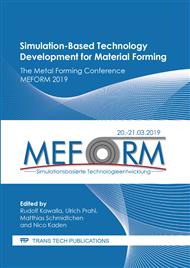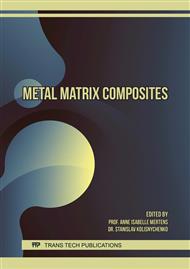p.1
p.7
p.15
p.24
p.32
p.40
p.48
p.57
Further Development of Process Maps for TRIP Matrix Composites during Powder Forging
Abstract:
Process maps according to Parasad et al. are already widely used to make statements about the formability of materials and their forming energy. However, these process maps only apply to conventional incompressible materials. At the TU Bergakademie Freiberg, these process maps have already been extended for particle-reinforced incompressible solid materials with a homogeneous particle distribution. The next step is to adapt the model for compressible particle-reinforced matertials so that they can also be used in powder metallurgy. The problem here is that the volume decreases as a result of compaction during powder forming. In powder metallurgy, however, compaction plays an important role. On the one hand, the compaction of the components leads to an increase in the material properties. On the other hand, pores pose a high risk of fractures and cracking. For this reason, it is the aim of this paper to make the existing process maps for incompressible materials usable for compressible materials by corresponding adaptations of the models prevailing in powder metallurgy. Furthermore, the effects of a homogeneous particle distribution and a graded particle distribution within the TRIP matrix composites on the process maps will be investigated. For this reason, process maps are produced in the temperature ranges between 700 – 1050 °C, with forming speeds of 0.001 – 100 s-1 and residual porosity of 10 – 30 %. For this purpose, specimens with corresponding residual porosity and homogeneously distributed ZrO2 5 vol.%, 10 vol.%, 15 vol.% and 20 vol.% as well as a graded layer structure of corresponding ZrO2 proportions are prepared. With the aid of these specimens, flow curves are determined and adjusted at appropriate temperatures and forming speeds during compression tests. The energy dissipation and an instability map are then modelled from these flow curves and a process map is derived. It was found that with increasing ZrO2 content in the homogeneous and the graded structure, the areas that allow damage-free forming become smaller. The same applies with decreasing residual porosity. Nevertheless, the areas, which allow failure-free forming, are larger than the possible forming areas of solid components. However, the power dissipation efficiency of incompressible specimens is significantly lower than that of compressible specimen [1]. In addition, it was observed that with increasing ZrO2 content and decreasing residual porosity, the efficiency of the power dissipation in the formable areas decreases. It was also found that the distribution of the reinforcing particles has a significant influence on the flow curves and the associated process maps, then the graded specimen do not represent a superposition of the individual process maps of the homogeneous specimens.
Info:
Periodical:
Pages:
15-23
Citation:
Online since:
March 2019
Authors:
Keywords:
Permissions:
Share:
Citation:



